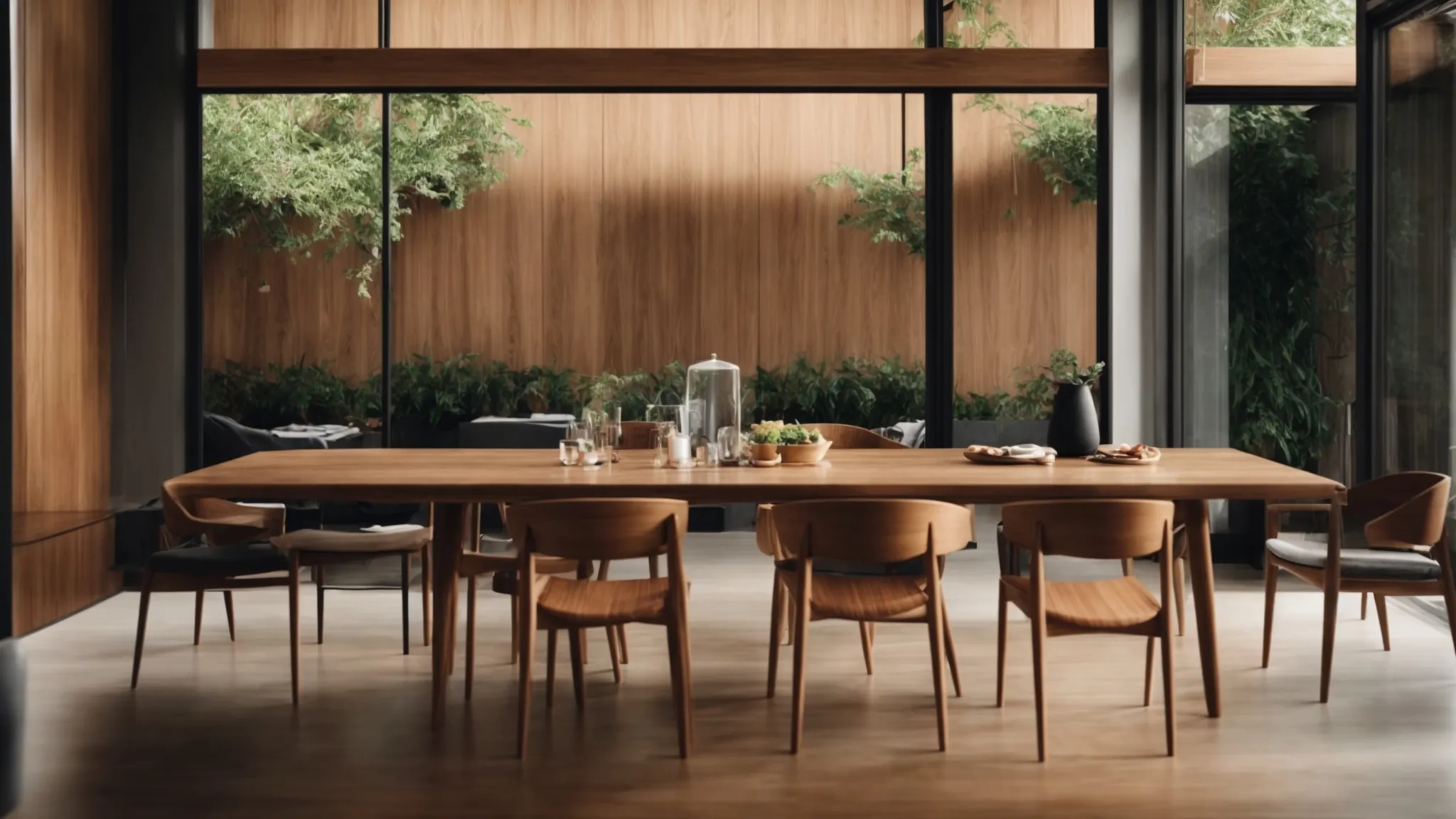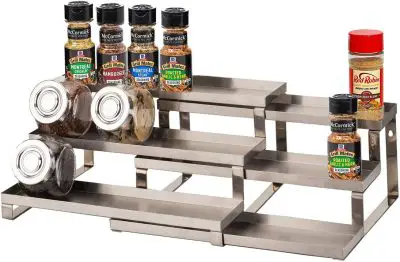Discover the Ideal Dining Chair Dimensions for Comfortable Seating
Selecting the perfect dining chair, not just for aesthetics but for comfort and compatibility with your space, can often feel like searching for a needle in a haystack.
Understanding the standard dimensions that make for comfortable seating is key, from ensuring there’s enough room under the table for your legs to confirming the chair’s height matches its companions.
Yet, with a myriad of design options—from classic wood to modern metal frames, choosing the right fit necessitates a deep dive into both ergonomics and style.
Moreover, considering the material can significantly impact the overall size and feel of the chair, affecting everything from the width of the seat to the height of the backrest.
Keep reading to discover how to navigate these waters smoothly, ensuring your dining area is both stylish and welcoming.

Key Takeaways
- Understanding Chair Dimensions Is Crucial for Dining Room Harmony and Comfort
- Material Choice Significantly Influences Chair Dimensions and Dining Space Aesthetics
- Custom Dining Chair Solutions Offer Unmatched Customization for Specific Needs
- Ergonomic Considerations Like Seat Height, Depth, and Backrest Angle Are Essential for Comfort
- Balancing Chair Dimensions With the Dining Area Layout Optimizes Both Functionality and Style
Understanding Standard Dining Chair Dimensions
Navigating through the maze of furniture design, I’ve come to realize that selecting the right dining chair involves much more than just falling in love with its appearance.
Ensuring comfort and style seamlessly blend involves understanding standard dining chair dimensions, a quest that initially seemed straightforward but quickly unfolded into a complex puzzle.
Delving into the importance of chair height for table compatibility reveals a critical foundation for dining room harmony, where every inch can impact legroom and overall dining experience.
Likewise, assessing the optimal chair width not only enhances comfort but also dictates how many chairs can elegantly fit around a table without feeling cramped.
Another aspect that demands attention is determining the ideal seat depth for extended seating, crucial for those long dinners or meetings that stretch for hours.
Lastly, the role of backrest height cannot be overlooked, as it significantly contributes to dining comfort, supporting the spine during meals.
Each of these dimensions plays a pivotal role in creating a dining space where function meets elegance.
The Importance of Chair Height for Table Compatibility
The journey to finding the perfect dining chair often begins with considering the chair height, especially when it comes to pairing it with your dining table: a vital step to ensure everyone can sit comfortably without the inconvenience of mismatched proportions. It’s about creating a space where people can gather around the dining room table, enjoying meals without a second thought about the awkwardness of a chair too tall or short for the table.
| Element | Standard Dimension |
|---|---|
| Chair Seat Height | 17-19 inches |
| Table Height | 28-30 inches |
| Distance Between Seat and Tabletop | 8-12 inches |
This calculated harmony between chair height and dining room table ensures that every diner, whether they’re enjoying a casual breakfast or a formal dinner, experiences the same level of comfort and convenience. The right height enhances the ergonomics of dining, preventing any discomfort that might distract from the meal and the conversation.
Optimal Chair Width for Comfort and Space Efficiency
Zeroing in on the optimal chair width isn’t just about ensuring everyone has enough elbow room; it’s about striking a balance between personal space and spatial efficiency. This careful balance allows for a fluid design that accommodates both comfort and the ability to navigate the dining area without obstruction.
Indeed, the quest to find the right chair width is a nuanced endeavor. Identifying the perfect dimension is essential not only for individual comfort but also for optimizing the layout of the dining room space: too narrow, and guests might feel cramped; too wide, and the room might lose its intimate ambiance:
| Element | Standard Dimension |
|---|---|
| Chair Width | 16-20 inches |
Aligning chair dimensions with the available space ensures a dining room environment that is both functional and aesthetic. It transforms the dining area into a place where gatherings become memorable, underpinned by seamless design considerations that put the diner’s comfort at the forefront.
Determining the Ideal Seat Depth for Extended Seating
Digging deeper into the essentials of dining chair design, I’ve pinpointed the criticality of seat depth for those prolonged periods of sitting. It’s not just about the immediate comfort; it’s about sustaining that comfort over courses of meals, discussions, and perhaps even a card game that follows dinner. An ideal seat depth assures that guests, regardless of their height, maintain proper posture without feeling the urge to constantly reposition themselves. Furniture oak
Upon reflection and numerous trials, I’ve discovered that the sweet spot for seat depth typically lies between 16 and 18 inches. This range seems to cater well to a broad spectrum of individuals, enabling a supportive seating experience that encourages engagement and relaxation. The difference it makes in a dining setup, bringing people together in a comfortable embrace, subtly elevates the entire dining experience beyond just the culinary delights on the dining room menu.
The Role of Backrest Height in Dining Comfort
The minutiae of selecting the perfect dining chair go beyond the seat and into the vertical plane, ushering in the role of backrest height for enhanced dining comfort. A well-proportioned backrest supports the diner’s spine through courses and conversation, making it a pivotal factor in the quest for a comfortable dining chair.
From my journey into the realms of interior design, I’ve learned that the ideal backrest height not only complements the aesthetic of the dining room but also ensures that the chair remains a bastion of comfort for everyone. It reconciles the need for both style and ergonomic support, serving as the backbone of the dining chair’s architecture. Wood is an essential material in this process:
| Element | Standard Dimension |
|---|---|
| Backrest Height | 18-20 inches |
How to Measure Your Dining Space for Perfect Chair Fit
Embarking on the journey to achieve the perfect fit of dining chairs within your space demands precision, insight, and a bit of creativity.
To navigate this aspect of room planning effectively, proper measurements of your dining area are imperative.
It’s not just about ensuring there is enough room for sedentary comfort, but also about preserving the aesthetic flow and functional access around the dining table.
This next segment offers a toolkit for embarking on this endeavor, coupled with a detailed, step-by-step guide designed to assist you in measuring your space with accuracy.
Additionally, garnering insight on calculating the exact number of chairs needed to complete your dining setup without overcrowding or underutilizing your available space will be valuable.
Through a blend of practical advice and interior design wisdom, we’ll explore how to harmonize dimension, design, and dining needs seamlessly.
Tools You’ll Need to Measure Your Dining Area
Embarking on the mission to tailor your dining space for the optimal chair fit begins with gathering the essential tools for precise measurements. A durable tape measure becomes my trusted ally, offering the accuracy needed to capture the dimensions of both the floor space and the dining table. This simple yet critical tool ensures that I can pinpoint the exact lengths and widths necessary to plot out the ideal dining room seating arrangement.
Additionally, I find that a bar stool and pencil are indispensable for jotting down these measurements and sketching preliminary layouts. As someone deeply engaged in the nuances of interior design, this allows me to record and play with different configurations on paper before making any definitive decisions. These tools, though basic, are fundamental in transforming the vision of a harmoniously designed dining area into reality, marrying function with form in every detail.
Step-by-Step Guide to Measuring Space for Chairs
The first step in measuring space for chairs around your dining room table occurs once you’ve equipped yourself with a tape measure, notebook, and pencil. Begin by determining the length and width of your dining area, focusing specifically on the floor space that will directly interact with the chairs. This initial action sets the groundwork, allowing you to visualize and apportion the available area effectively for seating arrangements.
After charting the dimensions of your dining space, the next move involves calculating the perimeter of your dining table to estimate how many chairs can comfortably fit. Remember, it’s not just about squeezing in as many bar stool as possible; you’re aiming for a balance between ample legroom and ease of movement around the table. Capturing these specifics serves as the blueprint in choreographing a dining ensemble that harmoniously blends style with functionality and furniture.
Tips for Calculating the Number of Chairs Needed
In calculating the number of chairs needed for your dining space, a pivotal step involves scrutinizing the chair width against the perimeter of your dining table: This calculation reveals the ideal balance between maximizing seating capacity and ensuring ample space for diner comfort and mobility. By focusing on chair dimensions, you foster a dining experience that gracefully accommodates your guests while preserving the room’s aesthetic and function.
| Chair Width | Perimeter of Dining Table | Number of Chairs |
|---|---|---|
| 18 inches | 180 inches | 10 chairs |
Furthermore, remember that the space between chairs is just as crucial as the chairs themselves. Allocating a standard distance of 6 inches between each chair ensures that guests can move freely and comfortably. This spacing strategy eliminates the elbow-to-elbow discomfort often found in overly cramped dining arrangements, optimizing both comfort and the dining room environment’s overall flow.
The Ergonomics of Dining Chair Design
Diving deeper into the ergonomics of dining chair design, it’s vital to appreciate how every aspect, from seat height to backrest angle, plays a critical role in ensuring a comfortable dining experience. Furniture wood plays a significant role in achieving this.
My exploration led me to understand that the height of a seat directly influences posture, prompting a profound realization of its importance.
Likewise, the depth of a seat emerged as a key factor in leg comfort, suggesting a nuanced approach to selecting the perfect chair.
Moreover, the revelation about the backrest angle offering essential support transformed my perspective on achieving ergonomic harmony in my dining space.
These intricacies collectively underscore the remarkable impact of chair design on comfort and well-being during dining.
How Seat Height Affects Your Posture
In my quest to unveil the essence of dining chair ergonomics, I’ve unearthed that the height of a dining chair seat foot is more than just a number; it’s a pivotal factor influencing your posture. Sitting at a chair that perfectly aligns with the height of the table ensures that my spine remains straight, warding off any discomfort or potential strain after prolonged periods of sitting.
This discovery led me to appreciate the invisible yet profound relationship between seat height and overall bodily support. Chairs that sit either too low or excessively high disrupt this delicate equilibrium, compelling me to contort into less natural positions to accommodate the mismatch. Ensuring a harmonious height match offers not just comfort but a safeguard for my foot during extended dining occasions with furniture.
The Impact of Seat Depth on Leg Comfort
Exploring the realm of seat depth for dining chairs, I’ve learned its significance stretches far beyond mere aesthetics; it directly influences leg comfort. A chair with inadequate seat depth forces me to perch uncomfortably on the edge, while excessively deep seating compels me to lean back, distancing myself from the table and straining to maintain an engaging posture during mealtime. Wood is a common material used in creating dining room furniture.
This balance is not just about personal comfort; it’s also about promoting healthy circulation. A seat depth that allows me to sit fully, with my back against the chair’s support, ensures my legs are comfortably bent at the knees, resting firmly on the floor or a footrest. This optimum arrangement prevents any undue pressure on the underside of my thighs, enhancing blood flow during prolonged seating:
| Element | Ideal Measurement |
|---|---|
| Seat Depth | 16-18 inches |
It became clear to me that the key to sustained comfort and well-being at the dining table lies in these ergonomic considerations. Finding that sweet spot in chair design transcends the dining room experience from merely functional to thoroughly enjoyable, underscoring the importance of ergonomics in furniture selection.
Selecting the Right Backrest Angle for Support
In my journey to refine each aspect of dining chair design, the discovery of how crucial the right backrest angle is for support stood out as a key element for ensuring a comfortable dining experience. A correct angle provides critical lumbar support, reducing the risk of back pain which can detract from the joy of dining, especially during extended periods at the dining room.
I found that a slight recline in the backrest, not too upright nor too laid back, strikes the perfect balance for both support and comfort. This detail often goes unnoticed but has a profound impact on the overall dining experience, confirming the philosophy that true comfort in dining chair design lies in the subtleties that cater to our body’s natural needs.
Navigating Different Styles and Their Dimensions
Embarking on a journey through the diverse world of dining chair styles, I’ve discovered that much like the rich tapestry of cuisine itself, the dimensions of chairs offer an array of flavors and preferences.
Comparing traditional versus modern dining chair sizes reveals a fascinating insight into how design epochs influence not just aesthetics but comfort and spatial dynamics.
As I delve deeper, it becomes apparent that the variation in dimensions among popular styles is not arbitrary but a reflection of evolving ergonomic understandings and interior design trends.
This exploration underscores the significance of understanding how chair design influences overall dimensions, shaping the dialogue between form, function, and the dining space they inhabit.
Comparing Traditional vs. Modern Dining Chair Sizes
Embarking on the analysis of traditional versus modern dining chair sizes, I unearthed stark contrasts that reflect broader shifts in lifestyle and interior design preferences. Traditional chairs, often crafted from sturdy materials like oak or mahogany, boast substantial dimensions that echo the grand dining spaces of the past.
Modern designs, on the other hand, lean towards minimalism and efficiency, leading to slimmer profiles and reduced dimensions. This evolution mirrors the contemporary inclination for sleek, multifunctional spaces, prioritizing cleanliness of design and the versatility to fit within the diverse layouts of modern homes: oak
| Style | Average Seat Height | Average Width | Average Depth |
|---|---|---|---|
| Traditional | 18 inches | 20 inches | 18 inches |
| Modern | 17 inches | 18 inches | 16 inches |
This table not only illustrates the palpable difference in dimensions but also symbolizes the shift in dining chair design philosophy from the elaborate to the streamlined. Bridging the gap between these styles involves a nuanced understanding of space, function, and aesthetics, ensuring that the chosen chairs enhance the dining experience in both comfort and style.
The Variation in Dimensions Among Popular Styles
In my relentless pursuit of comfort and style within the dining space, I’ve encountered a captivating diversity in chair dimensions across popular styles. From the plush, enveloping seats of French country designs to the streamlined simplicity of Scandinavian minimalism, each style carries its unique dimensional profile designed to elevate both the aesthetic and functional aspects of dining.
The revelation that even slight variances in dimension can significantly impact seating comfort led me on a comparative exploration of various styles, culminating in a comprehensive understanding of how these dimensions play out in real-world settings. To illustrate this intricate variety, I charted some of the most emblematic furniture styles like oak and their typical dimensions:
| Style | Average Seat Height | Average Width | Average Depth |
|---|---|---|---|
| French Country | 19 inches | 21 inches | 17 inches |
| Scandinavian | 18 inches | 17 inches | 16 inches |
| Industrial | 18 inches | 19 inches | 16 inches |
| Mid-Century Modern | 17 inches | 18 inches | 16 inches |
Understanding this variation not only enriched my design vocabulary but also sharpened my judgement in selecting furniture that promise both visual harmony and unmatched comfort in any dining room arrangement.
How Chair Design Influences Overall Dimensions
In my adventures through the realm of dining chair selection, I’ve come to understand that the architecture of a chair significantly dictates its overall dimensions. The integration of design elements such as armrests, backrest curvature, and seat depth not only defines a chair’s aesthetic appeal but also molds its space occupancy and user interaction with the surrounding dining room environment.
For instance, delving into the sleek silhouette of modern designs compared to the robust stature of traditional styles, it’s clear how design philosophy shapes dimension. A minimalist chair, crafted with slender steel frames and less imposing backrests, naturally occupies less room, offering an air of openness in the dining room. This contrast taught me to look beyond the mere measurements and appreciate how design intentions are behind every inch and angle of a chair.
Materials Matter: How They Impact Chair Dimensions
Embarking on the selection of the perfect dining chair, I’ve noticed that the choice of material such as wood plays a crucial role in determining dimensions such as width and depth, impacting not just the aesthetic but also the functionality of seating within a space.
Exploring different materials— from the elegance of oak to the modernity of steel frames—has taught me to consider how each affects the overall silhouette of a chair and, consequently, the spatial dynamics of a dining area.
This insight guides my decision-making process, ensuring the materials I choose not only complement the design vision but also fit practically within the unique constraints of the intended patio space.
The Effect of Material on Chair Width and Depth
In my examination of dining chair materials, I’ve uncovered that the choice between wood, metal, or plastic directly influences both the width and depth of a dining room chair. For instance, chairs crafted from solid oak or mahogany tend to have a substantial presence, requiring more space for both the seat’s width and depth to accommodate the material’s strength and aesthetic quality.
On the other hand, dining chairs designed with metal or plastic prioritize efficiency and modernity, leading to sleeker dimensions that offer minimalist appeal without sacrificing comfort. This insight taught me the importance of material consideration in achieving the right balance between space efficiency and wood presence in a dining setup.
Choosing Materials That Best Suit Your Space Constraints
Navigating the delicate process of selecting dining chairs takes me through a maze of materials, where each choice directly impacts how furniture is used and perceived. Opting for slender steel frames or molded plastic seats enables me to craft a dining area that feels open and airy, ideal for smaller spaces yearning for a touch of minimalism without compromising on style or comfort.
Conversely, embracing the robust character of solid oak or the rustic charm of beech offers an undeniable warmth and substance to the dining room setup, perfectly suited for larger spaces where the grandeur of the furniture complements the room’s scale. My approach aligns material choice with spatial constraints, ensuring that every dining chair not only serves its functional purpose but also enhances the room’s overall aesthetic and spatial harmony.
Tailoring Dining Chair Dimensions to Fit Your Needs
Navigating the quest for impeccable comfort and style in dining chair selection nudges me towards the contemplation of custom solutions.
This path, although less trodden, opens doors to unparalleled customization, tailoring every dimension to meet specific needs and preferences.
Initiating this journey, I become vigilant, questioning the very essence of what I seek in a chair’s form and function.
It becomes imperative to meticulously evaluate when the standard offerings fall short and custom solutions become not just viable but necessary.
This pursuit is not without its set of inquiries; delving deep into the specifics of customizing chair dimensions reveals a landscape rich with possibilities yet fraught with decisions that demand careful consideration of wood.
When to Consider Custom Dining Chair Solutions
Embarking on the quest for the perfect dining chair, I often entertain the idea of custom solutions when the market’s offerings seem not to conform to my unique spatial and aesthetic requirements. It’s during these moments that the allure of custom chairs becomes undeniable, appealing to my desire for tailor-made comfort that precisely matches the dimensions of my dining space and reflects my personal style. Whether for the kitchen or the dining room, furniture made from wood, metal, or steel frame could be the ideal choice for my needs. Oak could be the ideal choice for my needs.
Engaging with custom velvet dining chair solutions seems most prudent when conventional sizes impede the seamless flow of my dining room or when I notice a disconnection between the available designs and my envisioned interior theme. This bespoke approach not only affords me the flexibility to achieve an exact fit but also elevates the dining experience by introducing a level of customization that effortlessly melds function with elegance.
Questions to Ask Before Customizing Chair Dimensions
Before embarking on the journey of customizing dining chair dimensions, one critical question I always pose is,”How will these chairs interact with the existing layout of my dining area?” It’s a question that guides my understanding of spatial dynamics and ensures that any custom chair I consider harmonizes not just aesthetically, but also functionally within my designated space, enhancing both accessibility and comfort with wood.
Another imperative inquiry delves into the materials and their impact on the final design and dimensions of the bar stool. I ask,”Which materials will best embody the design vision while ensuring durability and comfort?” This question steers the selection process towards materials that not only match the visual narrative of the dining space but also offer the structural integrity to support customized dimensions, guaranteeing a balance between form and function.
Conclusion
Discovering the ideal dining chair dimensions is crucial for ensuring comfortable seating and enhancing the dining experience.
The journey begins with understanding the significance of chair height for table compatibility, which lays the foundation for dining room harmony by preventing legroom issues and mismatched proportions.
Additionally, identifying the optimal chair width strikes a balance between personal space and spatial efficiency, accommodating a comfortable number of guests around the table.
Seat depth also plays a pivotal role, especially for extended seating durations, ensuring guests can maintain proper posture and enjoy prolonged gatherings without discomfort.
Moreover, the backrest height contributes significantly to dining comfort by supporting the spine.
Properly measuring your dining space and considering the ergonomics of dining chair design, including seat height, depth, and backrest angle, further guarantees a comfortable and enjoyable dining dining room setup.
Ultimately, understanding and tailoring these dimensions, whether through standard choices or custom solutions, allows for a seamless blend of function, comfort, and style in your dining room.












